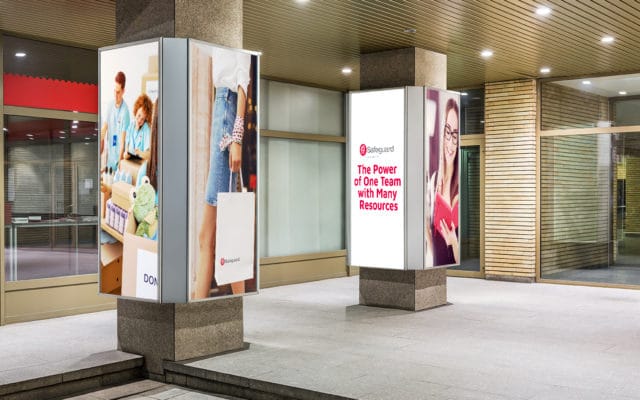Integrated Marketing Strategy 101: What It Is And Why Your Business Needs It
By Drew Galvin on July 3, 2023

An integrated marketing strategy is crucial for any business to succeed. What is integrated marketing, though, and why does it matter?
This blog will highlight marketing channels like direct mail, custom signage, giveaways, design, and packaging as pillars of success in the marketing solutions space, and how consistent marketing efforts can help your brand.
We’ll also review why working with a team of experts like Safeguard by Innovative can help streamline your marketing efforts and make your brand stand out. Before diving into all of that, let’s start with some basics.
What Is An Integrated Marketing Strategy?
Integrated marketing is a strategy that streamlines all of your marketing efforts among team members to produce data that allows you to understand your marketing’s effectiveness. It effectively connects all aspects of your marketing into one unified effort.
The key to integrated marketing is its omni-channel nature. You can focus on multiple marketing channels at once to reach more customers than you would by just using one marketing channel. Integrated marketing is therefore intrinsically omni-channel marketing.
Advertising is just one part of integrated marketing. Other aspects, like paid search ads, search engine optimization (SEO), and social media, are also essential to a robust integrated marketing strategy.
Why Do You Need An Integrated Marketing Strategy?
Now that we’ve covered some basic definitions, you might be wondering why your business needs an integrated marketing strategy. What exactly are the benefits of integrated marketing?
Benefit #1: Brand Consistency
Marketing efforts that aren’t integrated can create a scattered image of your company instead of a unified vision. With an integrated marketing strategy, messaging is streamlined and consistent across multiple channels.
Consistent messaging allows you to coordinate the same message across different channels in different formats. For example, direct mail and the use of promotional giveaways can use the same messaging to target prospective customers: direct mail targeting them at home, and promotional giveaways targeting them at trade shows or business conferences.
Consistency in marketing is key. Not only will you reach more people, you’ll also avoid confusing people by maintaining consistent messaging across all marketing channels.
Benefit #2: Increased Collaboration
Integrated marketing also promotes multiple people, or teams of people, working together to create marketing materials within your organization.
With collaboration, not only are you tapping diverse skill sets and backgrounds, you can also avoid duplicating efforts (e.g. sharing 1 video across multiple channels rather than making separate videos for 2 different channels), thus saving your business time and money. A cohesive effort also promotes the internal message that we are all rowing in the same direction.

How To Create An Integrated Marketing Strategy
Step 1: Identify Your Customer Base, Target Audience, Core Demographic, Or Persona
Before anything else, you need to find your core demographic or persona. You might have multiple demographics, and that’s okay. You can create several personas to fit a range of customers in your target market. Here are some questions to ask yourself about your audience persona:
- How old is your typical customer?
- What are some job titles that your typical customer could have?
- What are some of your typical customer’s interests?
- What are your typical customer’s needs or pain points?
- How do you solve their needs with your product or service?
Create a few different customer personas to give a face and a name to whom you’re serving.
Step 2: Start With A Content Idea
Your content should not just be about selling your product or service. It should tell the story of your brand or business, showcase who you are and what you do, and provide value to other people’s lives.
Content management systems (CMS) can be powerful tools for splitting content into multiple types. Consider using marketing software for insight tracking, analytics, and performance. You will want to track results and see how your content is performing across different channels.
Step 3: Choose Your Marketing Channels
Integrated marketing strategies require integrated distribution across multiple channels. What channels should you use?
The key to answering that is in Step 1. You need to know your customer first. What channels do they use? Are they fans of your blog content? Do they prefer printed communications, and therefore mailings? Let these answers dictate where you choose to market your brand. Essentially, go where your customers are.
Also, remember that customer preferences can change. Continually evaluate how your channels are performing and which platforms perform best to influence decisions about where you put most of your money, time, and resources.

Integrated Marketing Strategy Examples
Direct Mail
Direct mail marketing can help boost brand awareness and establish trust between your target audience and your brand. The key to running highly effective direct mail campaigns is to pair them with digital marketing and email follow-ups.
Co-marketing campaigns are just one way to implement integrated marketing strategies into direct mail campaigns. Email follow-ups and social media ads help remarket to your direct mail audience and increase the likelihood of a sale or desired action.
Looking for a way to integrate direct mail with digital marketing? Consider Direct Mail 2.0.
Custom Signage
Whether it’s marketing materials like posters, pull-up banners, or pop-up displays, indoor and outdoor signage keeps your customers informed and helps your brand stand out.
Digital marketing is only one aspect of a comprehensive integrated marketing strategy. Print media like custom signage can be beneficial for grabbing the attention of prospective customers when attending events like trade shows.
Especially for outdoor events, it’s important to have weather-proof custom signage that can withstand the elements. If you need help designing indoor or outdoor signage to give it that professional touch, Safeguard by Innovative offers creative design solutions.
Promotional Giveaways
Research shows that an average of 34% of customers are gained through promotional giveaways. When incorporated into your integrated marketing strategy, giveaways can boost brand awareness, increase website traffic, and help you grow a loyal customer base.
Many giveaways occur on social media, giving you an opportunity to grow your following and engagement across platforms like Facebook, Instagram, Twitter, LinkedIn, and YouTube.
Giveaway items should be selected based on your clientele’s interests (go back to identifying your persona to gain insight on what promotional items your customers would be interested in receiving).
Common giveaway items include thermal water bottles, tumblers, pens, apparel, and wireless chargers. Need help coming up with promotional giveaway items? Try Safeguard by Innovative’s promotional product generator to get some ideas.

Design And Packaging
What are the advantages of custom branding and packaging? Not only is it a powerful marketing tool that shows customers and prospects that you care about their experience with your brand, but when a promotional gift is packaged well, it makes the unboxing experience more memorable.
The design component of branding and packaging ensures brand consistency in your marketing. If your business relies on kitting or subscription services, you want the unboxing experience for your customers to be memorable and seamless.








